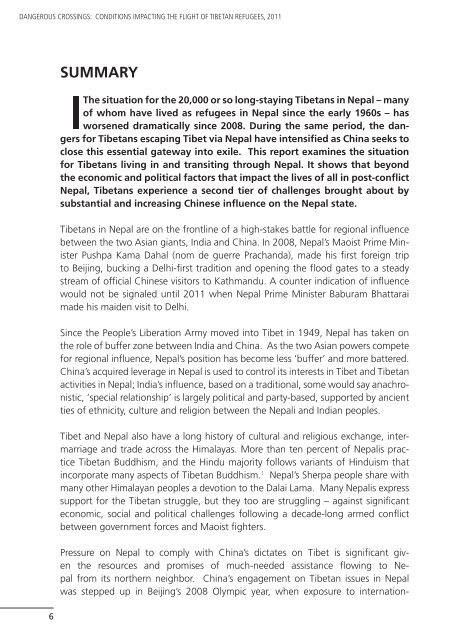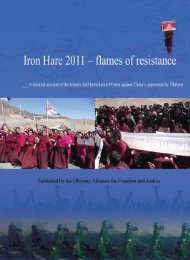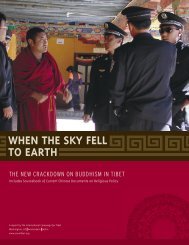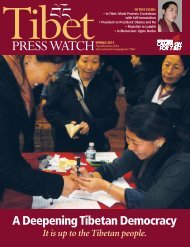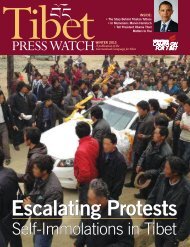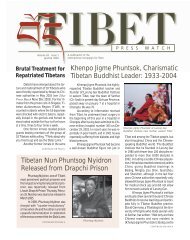DANGEROUS CROSSING: - International Campaign for Tibet
DANGEROUS CROSSING: - International Campaign for Tibet
DANGEROUS CROSSING: - International Campaign for Tibet
You also want an ePaper? Increase the reach of your titles
YUMPU automatically turns print PDFs into web optimized ePapers that Google loves.
<strong>DANGEROUS</strong> <strong>CROSSING</strong>S: CONDITIONS IMPACTING THE FLIGHT OF TIBETAN REFUGEES, 2011<br />
6<br />
SUMMARY<br />
The situation <strong>for</strong> the 20,000 or so long-staying <strong>Tibet</strong>ans in Nepal – many<br />
of whom have lived as refugees in Nepal since the early 1960s – has<br />
worsened dramatically since 2008. During the same period, the dangers<br />
<strong>for</strong> <strong>Tibet</strong>ans escaping <strong>Tibet</strong> via Nepal have intensified as China seeks to<br />
close this essential gateway into exile. This report examines the situation<br />
<strong>for</strong> <strong>Tibet</strong>ans living in and transiting through Nepal. It shows that beyond<br />
the economic and political factors that impact the lives of all in post-conflict<br />
Nepal, <strong>Tibet</strong>ans experience a second tier of challenges brought about by<br />
substantial and increasing Chinese influence on the Nepal state.<br />
<strong>Tibet</strong>ans in Nepal are on the frontline of a high-stakes battle <strong>for</strong> regional influence<br />
between the two Asian giants, India and China. In 2008, Nepal’s Maoist Prime Minister<br />
Pushpa Kama Dahal (nom de guerre Prachanda), made his first <strong>for</strong>eign trip<br />
to Beijing, bucking a Delhi-first tradition and opening the flood gates to a steady<br />
stream of official Chinese visitors to Kathmandu. A counter indication of influence<br />
would not be signaled until 2011 when Nepal Prime Minister Baburam Bhattarai<br />
made his maiden visit to Delhi.<br />
Since the People’s Liberation Army moved into <strong>Tibet</strong> in 1949, Nepal has taken on<br />
the role of buffer zone between India and China. As the two Asian powers compete<br />
<strong>for</strong> regional influence, Nepal’s position has become less ‘buffer’ and more battered.<br />
China’s acquired leverage in Nepal is used to control its interests in <strong>Tibet</strong> and <strong>Tibet</strong>an<br />
activities in Nepal; India’s influence, based on a traditional, some would say anachronistic,<br />
‘special relationship’ is largely political and party-based, supported by ancient<br />
ties of ethnicity, culture and religion between the Nepali and Indian peoples.<br />
<strong>Tibet</strong> and Nepal also have a long history of cultural and religious exchange, intermarriage<br />
and trade across the Himalayas. More than ten percent of Nepalis practice<br />
<strong>Tibet</strong>an Buddhism, and the Hindu majority follows variants of Hinduism that<br />
incorporate many aspects of <strong>Tibet</strong>an Buddhism. 1 Nepal’s Sherpa people share with<br />
many other Himalayan peoples a devotion to the Dalai Lama. Many Nepalis express<br />
support <strong>for</strong> the <strong>Tibet</strong>an struggle, but they too are struggling – against significant<br />
economic, social and political challenges following a decade-long armed conflict<br />
between government <strong>for</strong>ces and Maoist fighters.<br />
Pressure on Nepal to comply with China’s dictates on <strong>Tibet</strong> is significant given<br />
the resources and promises of much-needed assistance flowing to Nepal<br />
from its northern neighbor. China’s engagement on <strong>Tibet</strong>an issues in Nepal<br />
was stepped up in Beijing’s 2008 Olympic year, when exposure to internation-


